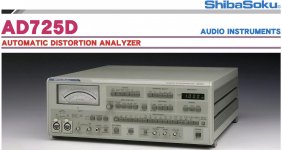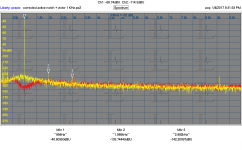What you will find amongst the analyzers is that they are very input level sensitive when looking at very low levels of harmonics. In other words, their non-linearity at low levels becomes apparent. I am looking to keep a 1dB tolerance on the harmonics of accuracy in measurement.
At levels below -100dB, the shielding is paramount to keep unwanted freqs from entering. I have resorted to extream measures in order to see the levels Davada has produced in his generator. But if the levels are not too bad and the extraneous field in the room isnt a total disaster..... I can drop the Victor pcb into an IC anti-electrostatic bag and get significant reduction in noise pickup (emi/rfi).
View attachment 589348 Victor's pcb in the bag.
THx-RNMarsh
Love that Viktor-osc-in-a-bag. He should send you a check for royalties!
Your point about the importance of INL and DNL in input ADCs is right on. It was clear that AP and R&S earn their keep with their own recipes on how to get this done to the levels they reached. Both companies had different signal pre-processing before the ADC to overcome conversion anomalies with low-level signals.
The more I found out how each company does it, the more it became clear that no soundcard can come close without a significant amount of DIY work. Each solution begets another unobtainable device (e.g. AG-15C, AD725D) or DIY circuits that require very specialized test equipment to validate (Twin-T at multiple frequencies, Ultra Low Distortion Oscillators that sweep), and the project ballooned. I had to decide whether I was more interested in the building of a world-class AF generator/analyzer or to use one that I can use to build projects with, and in the process learn from.
For now, that "build" part is a spectator sport for me - until I have more time, and know a helluva lot more than I do. When I look inside an R&S or ShibaSoku, I get very discouraged. Only poking around Krohn-Hite's gives me hope that "Yes I Can". I am a "user", with all the reverse accolades that apply.
This is what I get from Victors oscillator (early example running on batteries) at 1V into the Shibasoku 725 (modified). At 3 V the Victor distortion seems to go up. I have a passive 10 dB per step attenuator on its output so the input to the analyzer is constant but the harmonics increase significantly. Still more stuff to degrade your confidence in measurements below -100 dB.
Right now, i am comparing the data produced with various analyzers and generators. Can you measure with other analyzers and get the same identical results?
THx-RNMarsh
OK, tomorrow. I have an active twin T that is tuned close to the Victor so I can get a baseline. I don't have another analyzer in the same league as the 725 but I can check with my highly tweaked AK5394A demo board. Still the floor is about -130 dB.
I can drop the Victor pcb into an IC anti-electrostatic bag and get significant reduction in noise pickup (emi/rfi).
View attachment 589348 Victor's pcb in the bag.
THx-RNMarsh
Oh my God, it seems a great idea! : D
But seriously speaking, there is perfectly fitted enclosure on ebay:
1pc 100*65*35mm Electronic instrument Aluminum Box New box | eBay
This box is two times longer, then needed for an one board. The board in this box looks that:
http://content4-foto.inbox.lv/albums/e/elterra/SGbox/InBox.jpg
The other seller:Too bad he doesn't ship to Canada (Why?)
1pcs White Electrical Instruments Aluminum Box 100*65*35mm DIY | eBay
I can drop the Victor pcb into an IC anti-electrostatic bag and get significant reduction in noise pickup (emi/rfi).
As used at the old HW days as or similar 16 | Rf | Products | Electronic enclosures - Metal 😀
Hp
But is this as good as a Danish cookie tin? I'm sure it's not as fattening, but some sacrifices must be made for Science...I can drop the Victor pcb into an IC anti-electrostatic bag and get significant reduction in noise pickup (emi/rfi).
View attachment 589348 Victor's pcb in the bag.
THx-RNMarsh
You got a wrong number there the AD725 is an obsolete RGB to NTSC/PAL converter. Reminds me of the "Jack of Diamonds" test. The customer just said open up solitaire and find the jack of diamonds to find the image glitch they didn't like.(e.g. AG-15C, AD725D)
You got a wrong number there the AD725 is an obsolete RGB to NTSC/PAL converter. Reminds me of the "Jack of Diamonds" test. The customer just said open up solitaire and find the jack of diamonds to find the image glitch they didn't like.
This is the one I mean.
Attachments
Thank you for sharing. I have been using Hammond extruded aluminum enclosures, but I always seem to need a larger size than they sell.
You got a wrong number there the AD725 is an obsolete RGB to NTSC/PAL converter. Reminds me of the "Jack of Diamonds" test. The customer just said open up solitaire and find the jack of diamonds to find the image glitch they didn't like.
AD725D is the correct model number according to Shibasoku's 725D calibration manual.
Oh I see. The AD725 is an Analog Devices IC.
Scott makes funny joke.
Last edited:
You got a wrong number there the AD725 is an obsolete RGB to NTSC/PAL converter. Reminds me of the "Jack of Diamonds" test. The customer just said open up solitaire and find the jack of diamonds to find the image glitch they didn't like.
And this is the current replacement VC7 Multi-format Standards Converter for 60 dB X the cost?
Oh my God, it seems a great idea! : D
But seriously speaking, there is perfectly fitted enclosure on ebay:
1pc 100*65*35mm Electronic instrument Aluminum Box New box | eBay
This box is two times longer, then needed for an one board. The board in this box looks that:
http://content4-foto.inbox.lv/albums/e/elterra/SGbox/InBox.jpg
The fingered steel boxes are designed to minimise the slot length through which emi leaks. (HpW's posted link).
How badly do the long slots in the other enclosures leak?
Do we need to fit electrically conducting gaskets into the slots to make them effective for emi attenuation?
Right now, i am comparing the data produced with various analyzers and generators. Can you measure with other analyzers and get the same identical results?
THx-RNMarsh
Per request here is the Shibasoku and an active twin T superimposed. The harmonics agree to around 1 dB. Its hard to see that difference. Yellow is the active twin T and red is the Shibasoku. This suggests that the harmonics of my Victor are around -133 H2 and -142 H3. This is an earl example and victor has improved them since. He sent me the details of the upgrade but I have been too busy to either upgrade or get another so far. This is on battery for both the oscillator and the notch. AC power brings a ton of other crud.
Attachments
Per request here is the Shibasoku and an active twin T superimposed. The harmonics agree to around 1 dB. Its hard to see that difference. Yellow is the active twin T and red is the Shibasoku. This suggests that the harmonics of my Victor are around -133 H2 and -142 H3. This is an earl example and victor has improved them since. He sent me the details of the upgrade but I have been too busy to either upgrade or get another so far. This is on battery for both the oscillator and the notch. AC power brings a ton of other crud.
This is close enough to two other machines for comparison --- the 7722A reads 2H = -133, 3H = -146 (re 1v); The 725D reads 2H = -138, and 3H = -145
But my AP 2722 is way off the mark. I will have to tear into it tomorrow. AP sent me a matched pair of input amp pcb's. Very nice of them to respond quickly and surprised they had the input pcb's in stock.
THx-RNMarsh
- Home
- Design & Build
- Equipment & Tools
- Low-distortion Audio-range Oscillator

